Microsoft Flight Simulator Handbook
by Jonathan M. Stern
Terminal NDB Approach
Want to try one more NDB approach? Another slightly unusual one is the NDB Rwy 27R IAP to Oakland, California. Recall the BayWatch situation.
Figure 18.40 contains the approach chart for this approach to Metro Oakland International Airport.
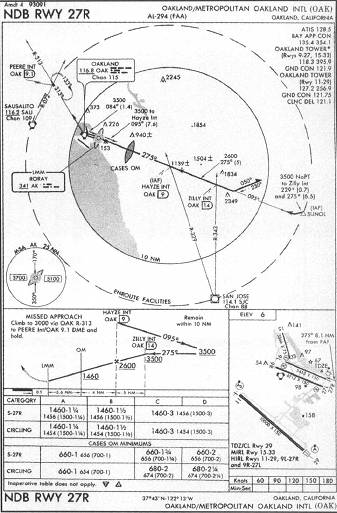
Study the chart, noting that this is a terminal NDB approach. What is unusual about this approach is that the NDB is collocated with the middle marker, forming an LMM or locator middle marker, and that the outer marker is not collocated with an NDB. The NDB/middle marker is the missed approach point on this approach.
The approach procedure is actually quite simple. You are flying from Woodside VORTAC direct to San Jose, and from San Jose direct to HAYZE intersection. Although this is not a published route, in my position as air traffic controller, I will authorize the direct routing at 5,000 feet.
After you turn onto the approach at HAYZE, it's a straight shot to the runway, tracking inbound on the 275° bearing to the NDB. There is one step-down fix, the CASES outer marker. If you pass the NDB without having the prerequisites to descent and landing, follow the published missed approach procedure.
- Unpause the simulation and proceed direct to San Jose (frequency 114.1) while descending to 5,000 feet. (See Figure 18.41.)
Figure 18.41. Do you know the way to San Jose? That's it under the nose with the three parallel runways.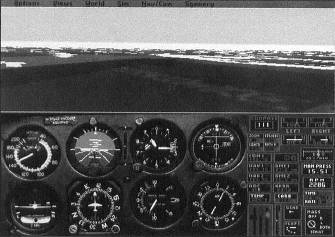
- Track the 329° radial from San Jose to HAYZE intersection.
- Meanwhile, tune the ADF to RORAY on 341. Calculate the relative bearing that indicates interception of the final approach course by using the formula MH + RB = MB. Thus, RB = MB - MH. In this case, RB = 275-329 (assuming no wind), or -54.
Negative relative bearings indicate the angular distance counterclockwise from 0, so that -54° yields a relative bearing of 306° (360-54).
- While approaching HAYZE, perform the Before Landing checklist. I found that the ADF came alive about 13 DME Northwest of San Jose.
- When the relative bearing approaches 306°, slow the airplane to approach speed, lower the landing gear, and turn left and track inbound on the 275° bearing to HAYZE. (See Figure 18.42.)
Figure 18.42. The relative bearing of 306° tells you that you are arriving at HAYZE intersection.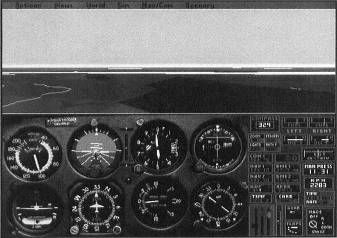
- As soon as you have intercepted the 275° bearing to the NDB, dirty the airplane with flaps and start the descent to 1,460 feet. You have less than nine miles to lose 5,000 feet. The necessary rate of descent is calculated using the following formula: descent rate = feet to descend* (groundspeed/(60* miles)). At 90 knots groundspeed, an 833 foot per minute descent is necessary.
- CASES outer marker is a step-down fix that allows descent from 1,460 feet to the MDA, 660 feet. After passing CASES, descend to 660 feet. (See Figure 18.43.)
Figure 18.43. The outer marker light indicates that you are at CASES. Because you arrived at HAYZE at 5.000 feet, you need landing gear and flaps to assist you in getting the airplane down without building up excessive airspeed.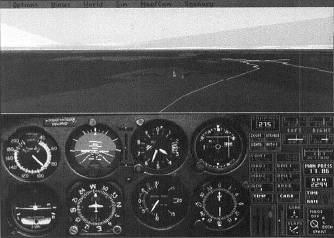
- Level the airplane at the MDA, adding power as necessary to maintain approach speed. When you pass RORAY, the ADF needle turns left or right past the 90° or 270° relative bearing (depending on which side of the NDB you are on as you pass). This indicates station passage and requires that you execute the missed approach procedure if you do not have the runway in sight or are not in a position from which a normal landing can be made using normal maneuvers and procedures. If you meet the requisite criteria, descend and land on runway 27R. (See Figure 18.44.)
Figure 18.44. Continuing the approach below the MDA with all the requirements satisfied.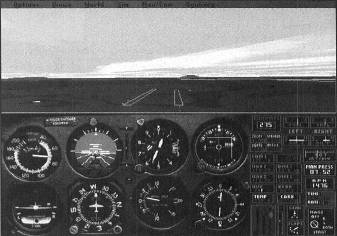
Table of Contents
Previous Section: Non-Terminal NDB Approach
Next Section: ILS Approaches
